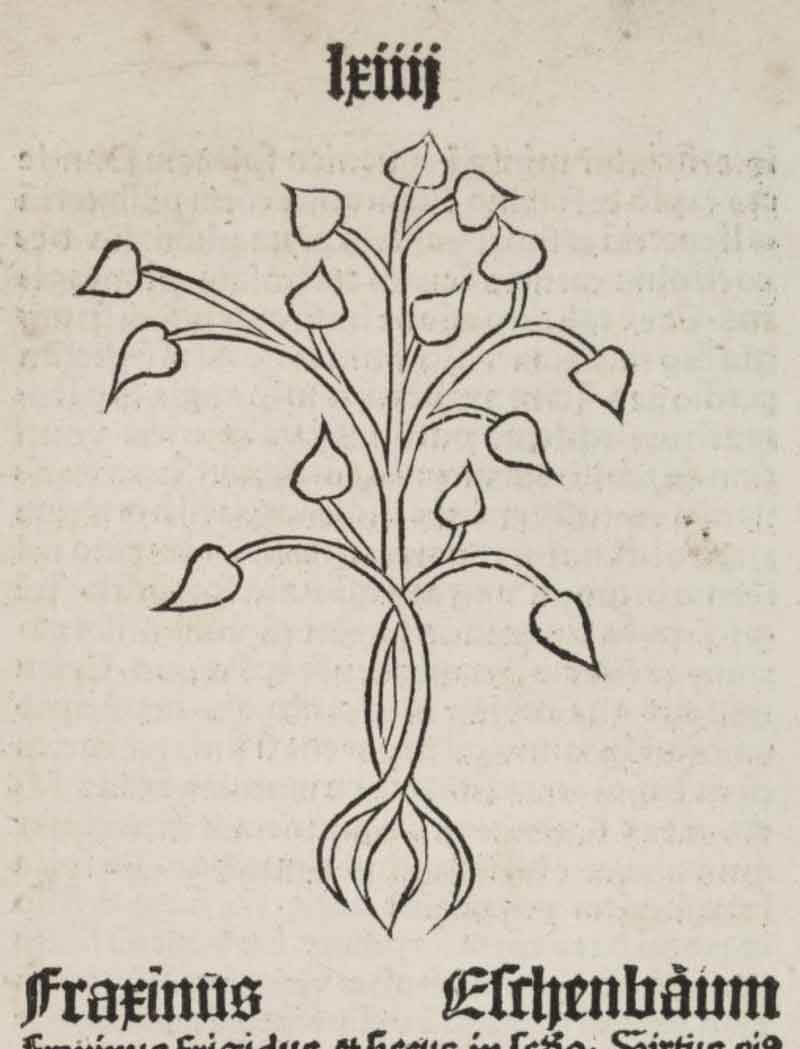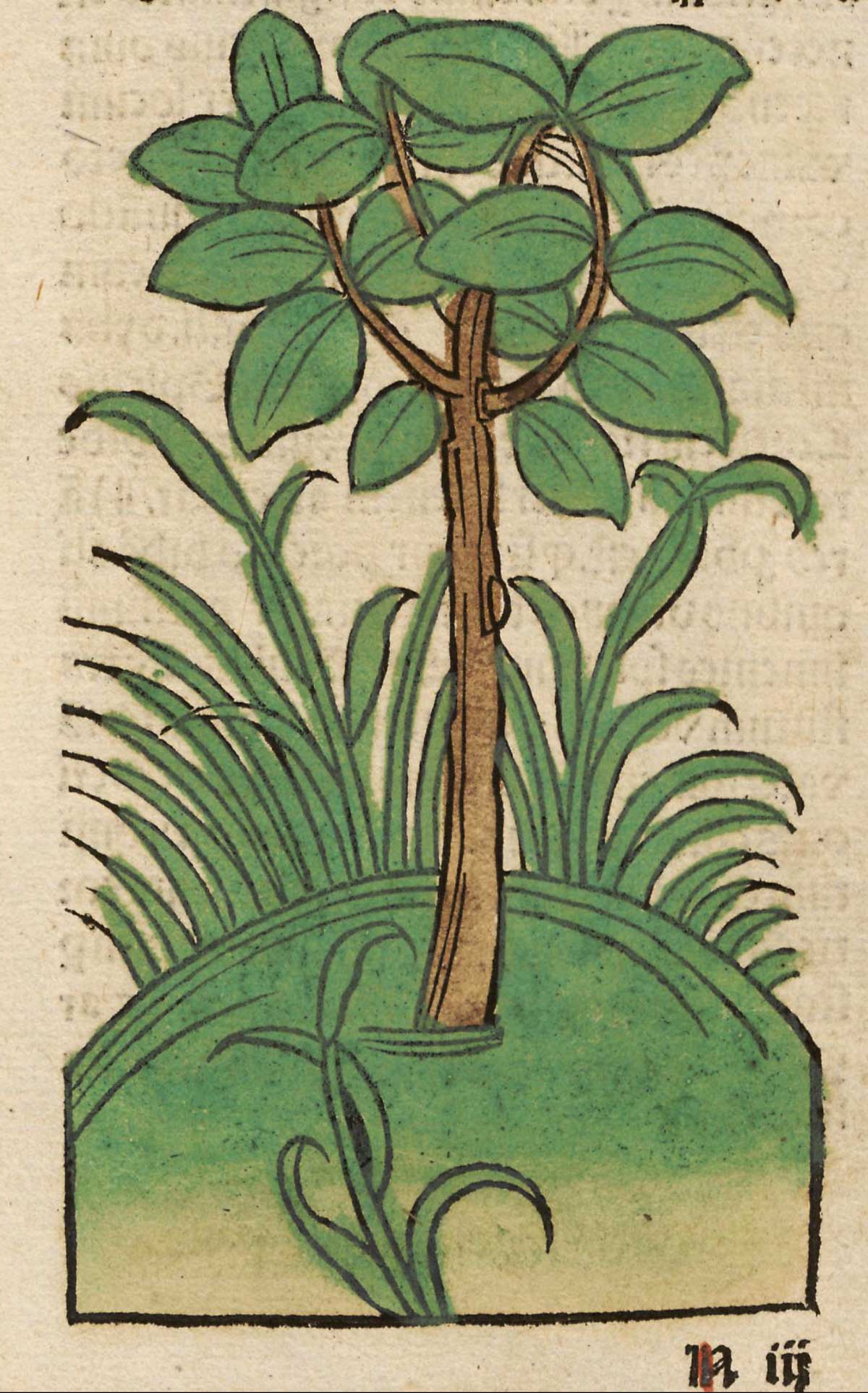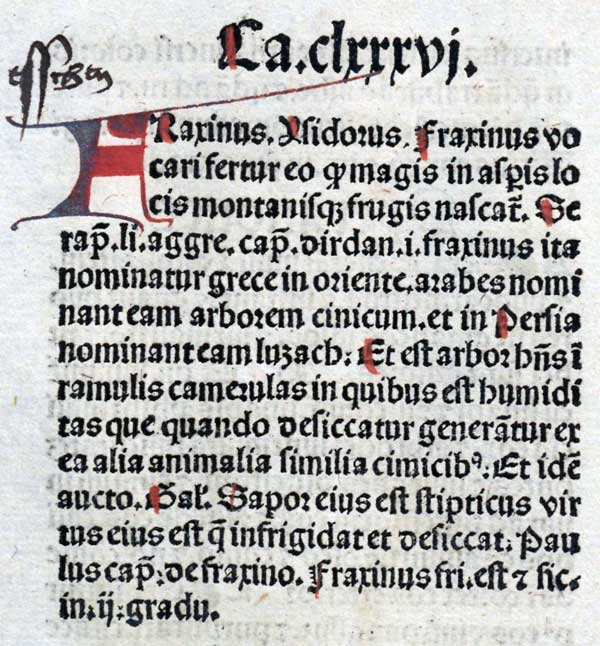Among plants in some way similar to Pantagruelion, referred to throughout Chapter 49.
The leaves of the ash are similar to the leaves of Pantagruelion.
Notes
Fraxinus
Fraxinus
Fraxinus (text)
fresne
Le Frêne, Fraxinus excelsior L. (Oléacée), a des feuilles composées, à folioles ovales lancéolées, dentées. (Paul Delaunay)
Cannabis
Dioscorides 3.165 Kannabis Emeros. Cannabis [some call it Cannabium, some Schoenostrophon, some Asterion, ye Romans Cannabis] is a plant of much use in this life for ye twistings of very strong ropes, it bears leaves like to the Ash, of a bad scent, long stalks, empty, a round seed, which being eaten of much doth quench geniture, but being juiced when it is green is good for the pains of the ears.
ash
ash. Forms: æsc, asse, aychs, assch, asch, assh, ashe, aish, esche, ach, ash.
[Common Teut.: OE. æsc is cogn. with ONor. askr, Old High German ask,Middle High German asch, mod.G. esche, OTeut. *ask-oz.]
A well-known forest tree, indigenous to Europe, Western Asia, and North Africa, and noted in Teutonic literature from the earliest times; having silver-grey bark, graceful pinnate foliage, a peculiar winged seed or samara called the `ash-key,’ and very tough close-grained wood valuable for implements. The tribe of trees Fraxineæ, N.O. Oleaceæ, including the common ash (Fraxinus excelsior), and the manna or flowering ashes (Ornus Europæa and rotundifolia).
C. 700 The Epinal Glossay Latin and Old English 416 Fraxinus, aesc.
935 Chart. Æthelstan in Cod. Dipl. V. 221 On ðæne ealdan æsc.
A. 1300 W. de Biblesw. in Wright Voc. 171 De frene, of asse.
C. 1305 St. Kenelm 171 in E.E.P. (1862) 52 A gret asch… stent in þulke place.
C. 1380 Sir Ferumb. 5248 Þe Emperour him li3t a-doun anon, Vnder an Aychs.
C. 1386 Chaucer Knights Tale 2064 Wilw, elm, plane, assh.
C. 1440 Promptorium parvulorium sive cleriucorum Esche, fraxinus.
1504 Plumpton Corr. 188 The okes are sold… & the aches.
1596 Edmund Spenser Faerie Queene i. i. 9 The warlike beech; the ash for nothing ill.
1847 Blackwell Malet’s Northern Antiquities 413 (tr. Edda) The ash Yggdrasill… is the greatest and best of all trees. Its branches spread over the whole world, and even reach above heaven.
The wood or timber of the ash-tree.
C. 1380 John Wyclif Sel. Wks. (1871) III. 500 An ymage… of oke or of asshe.
C. 1450 Merlin xxii. 390 A grete growe spere of aish.
The ashen shaft of a spear; a spear. Obsolete
A. 1000 Beowulf 3548 Æscum and ecum.
1607 Shakspeare Coriolanusiv. v. 114 That body, where against My grained Ash an hundred times hath broke.
1700 Dryden Pal. & Arcite iii. 513 The tourney is allowed but one career Of the tough ash, with the sharp-grinded spear.
ash
Materiae enim causa reliquas arbores natura genuit copiosissimamque fraxinum. procera haec ac teres, pinnata et ipsa folio, multumque Homeri praeconio et Achillis hasta nobilitata. materies est ad plurima utilis. ea quidem quae fit in Ida Troadis in tantum cedro similis ut ementes fallat cortice ablato. Graeci duo genera eius fecere: longam enodem, alteram brevem duriorem fuscioremque, laureis foliis. bumeliam vocant in Macedonia amplissimam lentissimamque. alii situ divisere, campestrem enim esse crispam, montanam spissam. folia earum iumentis mortifera, ceteris ruminantium innocua Graeci prodidere; in Italia nec iumentis nocent. contra serpentes vero suco expresso ad potum et imposita ulceri opifera ut nihil aeque reperiuntur; tantaque est vis ut ne matutinas quidem occidentesve umbras, cum sunt longissimae, serpens arboris eius adtingat, adeo ipsam procul fugiat. experti prodimus, si fronde ea circumcludantur ignis et serpens, in ignes potius quam in fraxinum fugere serpentem. mira naturae benignitas prius quam hae prodeant florere fraxinum nec ante conditas folia demittere.
For it is for the sake of their timber thatThe ash: varieties, localities and uses. Nature has created the rest of the trees, and the most productive of them all, the ash. This is a lofty, shapely tree, itself also having feathery foliage, and has been rendered extremely famous by the advertisement given it by Homer [Il. XX. 277 Πηλιάς . . . μελίη] as supplying the spear of Achilles. The wood of the ash is useful for a great many purposes. The kind grown on Ida in the Troad so closely resembles cedar-wood that when the bark has been removed it deceives buyers. The Greeks have distinguished two kinds of ash-tree, a tall one without knots and the other a short tree with harder and darker wood and foliage like that of the bay-tree. In Macedonia there is a very large ash making very flexible timber, which has the Greek name of ‘ox-ash.’ Other people have distinguished the ash-tree by locality, as they say that the ash of the plains has a crinkly grain and the mountain ash is close-grained. Greek writers have stated that the leaves of the ash are poisonous to beasts of burden, though doing no harm to all the other kinds of ruminants; but in Italy they are harmless to beasts of burden also. Indeed, they are found to be serviceable as an exceptionally effective antidote for snake-bites, if the juice is squeezed out to make a potion and the leaves are applied to the wound as a poultice; and they are so potent that a snake will not come in contact with the shadow of the tree even in the morning or at sunset when it is at its longest, so wide a berth does it give to the tree itself. We can state from actual experiment that if a ring of ash-leaves is put round a fire and a snake, the snake will rather escape into the fire than into the ash-leaves. By a marvellous provision of Nature’s kindness the ash flowers before the snakes come out and does not shed its leaves before they have gone into hibernation.


